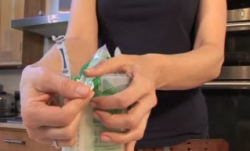Can you Jugit? PFM spies rosy UK milk bag future with new machine

The PV200 Inox has been designed with simple operation in mind and – as UK sales and operations director for the Italian headquartered firm, Chris Bolton, explained, afavourable cost/performance ratio.
Built from stainless steel, the machine is capable of filling up to 60 one-litre polyethylene bags of milk a minute, and PFM said its dosing system required minimal maintenance and had an electronically timed flow.
It can also be connected to a clean-in-place washing system, which allows automatic cleaning of its mixing tank, milk dosing unit and dosing tube.
Bolton said that the leading UK supermarkets were trying to encourage consumers to purchase more bagged milk, with increasing opportunities for even relatively low volume dairies in this sector.
Supermarket trials
Accordingly, UK marketing and advertising manager, Alison Davies, told DairyReporter.com such machines had real potential: “A few supermarkets did a pilot on it [bagged milk] recently. I think Waitrose and possibly Sainsbury’s, with the jug system.”
Launched by Dairy Crest in June 2008, ‘Jugit' is a reusable plastic jug (pictured) designed for use with milk bags, and the company claims they use 75% less packaging than standard HDPE plastic milk bottles on UK sale.
Davies said: “We’ve made these bags for a long time, but they’re sold mainly on the continent. It a European thing but also further afield than that really.”
Although mainland Europe is the biggest market for such machine, PFM has sold its wider Inox series worldwide – in the Caribbean, Eastern Europe, Spain, Finland and North Africa.
Ultrasonic sealing
The company said its recent Inox models were available with ultrasonic sealing, and Davies described its benefits: “Conventional sealing uses heat, which is applied to the wrapping material, which is welded through heat,” she said.
“Ultrasonic sealing is done by ultrasonic sound, and what it means for the end user is that the seal is a lot more precise, and it will seal through any kind of debris: liquids, powders or anything like that.
She added: “Whereas before if you maybe got powder or liquid in a seal, that would cause a leak within the pack. You can also reduce the size of the seal – thus reducing your material use.”
So to what extent was ultrasonic sealing taking off in the global marketplace? “It’s becoming more and more popular. It’s quite popular within salads and things like that,” Davies said.
“As you can imagine, leaves get in the seals and its very wet environment. In a damp, wet environment, or when there’s likely to be debris in the seals, it would be more relevant.”
Asked whether speed and size were the two main benefits when customers moved up the Inox range, Davies said: “There are faster and bigger machines, but you’d possibly be restricted a bit by the dosing pump, because the milk has to be dosed into the bags.”







